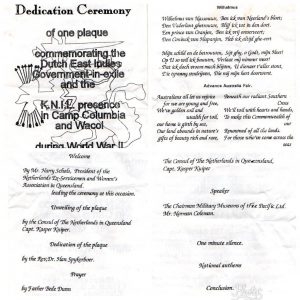The Dutch planned to stay in Camp Columbia until the liberation of sizeable towns in the NEI. People from these liberated towns could provide relief to their acute staff shortage across all NEI organisations. As no such large population centre were liberated, the NEI government-in-exile remained at Wacol until War’s end in September 1945, however the site remained in use by the NEI Government until March 1946[6]. Most officials and their offices moved to the NEI. Part use of Camp Columbia continued into 1947 when some barracks and houses were used for the recuperation of Dutch victims of the Japanese occupation of NEI who had been put into concentration camps. In groups they stayed for 3 to 6 month in Wacol (and elsewhere in Australia) again with the full support support of the Australian Government.
The facility was consequently greatly extended into an Australian refugee and migration camp . By 1949, it is estimated that one-tenth of the old Camp Columbia area became the Wacol East Displaced Persons Holding Camp. In the early 1950s the camp was developed to become the Wacol Migrant Centre, the biggest in Queensland. In 1952, the 1600 people capacity of the camp was exceeded, reaching close to 2000. The initial post-war refugee program was transformed into a larger program of re-settling migrants from Europe. A number of houses along Wilruna Street, close to Wacol Station were used for the refugees from NEI. This was close to the Gailes Golf Club, its clubhouse was used by the military officers.

By the 1980s the converted timber Army huts were aging and a different model for receiving immigrants was evolving. The Wacol Migrant Centre was closed in 1987. The Prisons Department took over the site and the Arthur Gorrie Correctional Centre was opened in 1992.